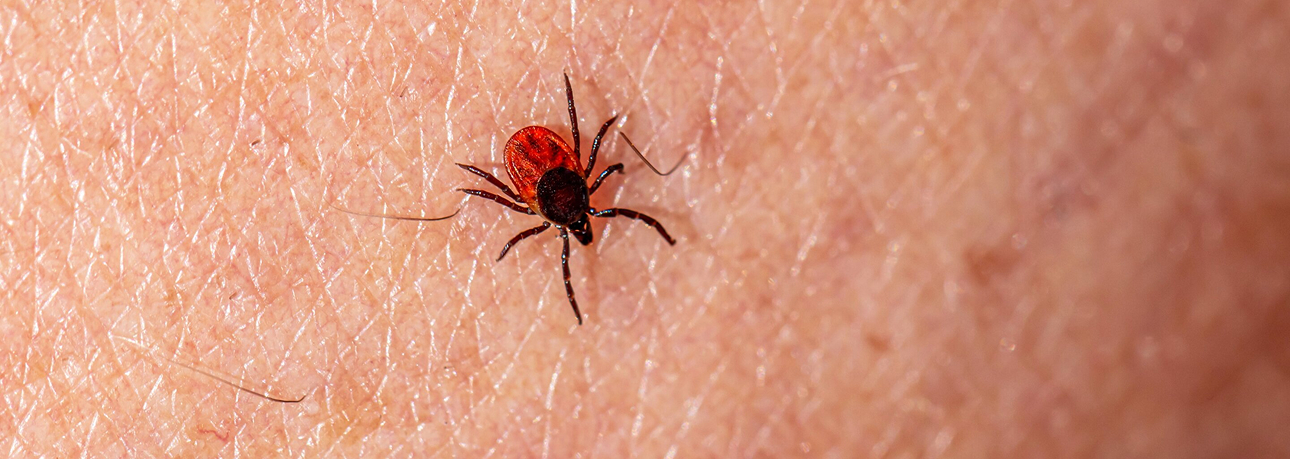Ticks Removal Service
Tick Control Services in Orange County, CA
Ticks are small, blood-feeding arachnids that can pose health risks to both humans and pets. In Orange County, several tick species are commonly encountered, and their presence can lead to the transmission of diseases such as Lyme disease and Rocky Mountain spotted fever. Understanding their behavior, life cycle, and effective control measures can help prevent infestations and reduce health risks.

Common Tick Species in Orange County
Western Black-Legged Tick (Ixodes pacificus)
Identification
This tick is small, with adult females measuring about 3 mm before feeding and growing larger when engorged. They have an orange-brown body with black legs, and their nymphs are often mistaken for tiny spiders due to their small size.
Behavior
Western black-legged ticks are commonly found in grassy or wooded areas where they latch onto humans, pets, and wildlife. They are the primary vector of Lyme disease in California.
Common Tick Species in Orange County
Western Black-Legged Tick (Ixodes pacificus)
Identification
This tick is small, with adult females measuring about 3 mm before feeding and growing larger when engorged. They have an orange-brown body with black legs, and their nymphs are often mistaken for tiny spiders due to their small size.
Behavior
Western black-legged ticks are commonly found in grassy or wooded areas where they latch onto humans, pets, and wildlife. They are the primary vector of Lyme disease in California.
American Dog Tick (Dermacentor variabilis)
Identification
Larger than the western black-legged tick, the American dog tick has a brown body with white or gray markings. Females can grow significantly when engorged after feeding on a host.
Behavior
These ticks prefer open, grassy areas and frequently attach to dogs and humans. While they do not transmit Lyme disease, they are known carriers of Rocky Mountain spotted fever and tularemia.
Life Cycle
Ticks undergo a four-stage life cycle:
1. Egg
Laid by adult females in sheltered areas such as leaf litter.
2. Larva (Seed Tick)
Hatch and seek out a small host for their first blood meal.
3. Nymph
Molt into a larger form and require another host for feeding.
4. adult
Fully mature and actively seek larger hosts, including humans and pets.
Ticks require a blood meal at each stage to progress through their life cycle, making effective control crucial for breaking their reproductive cycle.
diet
Ticks are obligate blood feeders, meaning they rely on host blood for survival. They attach to:
- Humans
- Pets (dogs and cats)
- Wildlife (rabbits, rodents, deer, etc.)
Once attached, ticks can remain on a host for several days, feeding until fully engorged before dropping off to molt or lay eggs.
Habitat
Ticks thrive in:
- Grassy fields and wooded areas
- Leaf litter and dense vegetation
- Animal nesting sites and burrows
- Dog parks and areas with high pet activity
Ticks often wait in shaded, humid areas, positioning themselves on vegetation where they can latch onto a passing host.
At Wipe Out Pest Control, we offer safe, effective tick control throughout Orange County, including Orange, Placentia, Tustin, Anaheim, and Huntington Beach. Whether you’re seeing ticks in your yard or worried about pet exposure after walks in local parks, our expert team provides targeted treatments for long-term relief. We understand the local tick species, their habits, and how to break the lifecycle safely—for both your family and your pets.
Key Takeaways and Control Methods
Ticks can be dangerous due to their role in disease transmission. Here are effective strategies for managing and preventing infestations:
Regular Pet Protection
Use vet-approved tick prevention products such as collars, topical treatments, or oral medications for pets.
Personal Protection
Wear long sleeves, use insect repellent containing DEET or permethrin, and perform tick checks after outdoor activities.
Maintain Landscaping
Keep grass short, remove leaf litter, and trim vegetation to reduce tick-friendly habitats.
Create Barriers
Use gravel or wood chips to create dry buffer zones between wooded areas and frequently used spaces.
Proper Removal
Use tweezers to grasp ticks close to the skin and pull them out slowly to avoid leaving mouthparts behind.
Professional Treatment
For severe tick infestations, professional pest control services can provide targeted treatments to reduce tick populations.
If you are dealing with a tick problem around your home or need expert advice on tick prevention, our pest control team is here to help. Contact us today for professional tick control solutions to keep your family and pets safe!
FAQS
Do you provide tick control in Tustin and Orange, CA?
Yes! We serve homes and businesses in Tustin, Orange, Placentia, and other Orange County cities.
Are your tick treatments safe for pets and children?
Absolutely. Our treatments are designed with pet safety in mind and applied carefully to protect your family.
Where do ticks hide around my home?
Ticks thrive in tall grass, leaf litter, under decks, and near pet rest areas. We target these zones during treatment.
How often should I treat my yard for ticks?
We recommend quarterly treatments, especially during spring and summer, when tick activity is highest.
Can ticks cause disease in Southern California?
Yes, ticks in Orange County can transmit Lyme disease, Rocky Mountain spotted fever, and more. Regular control is essential.
our services
Simple Solutions To Complex Problems at an Affordable Rate

Residential
We offer a variety of plans custom fit for your needs! Whether its an endless trail of ants, or strange noises in the walls, we’ve got your pest control needs covered!

Commercial
We can stop pests from causing costly machinery repairs, fines, closures, and damage to your reputation!

rodents
Various species of rats and mice inhabit the Orange County area. Remove rodents from your home permanently with our exclusion services.

mosquito
We use the In2Care system to eliminate mosquitoes where they breed—protecting your family’s health and comfort.

